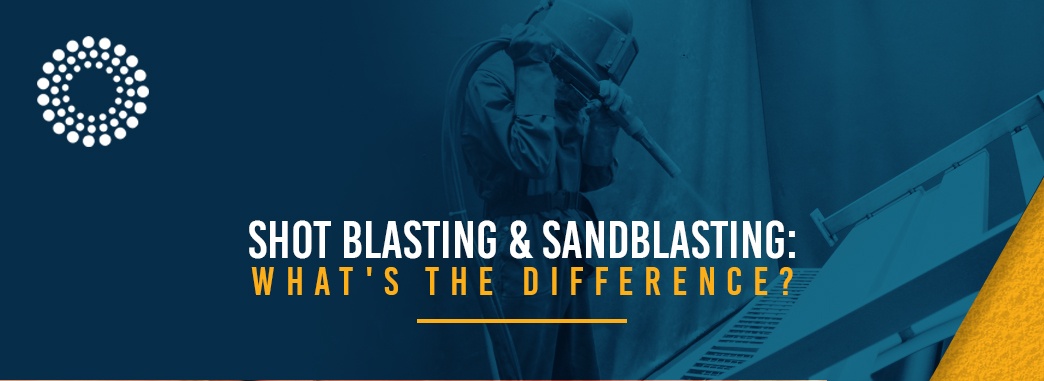If you're new to surface preparation, you might be confused between sandblasting and shot blasting. While they both fall under the broader category of abrasive blasting, they are quite different in terms of technique, application, and safety. Sandblasting is a process where compressed air is used to propel abrasive materials like sand against a surface. On the other hand, shot blasting uses mechanical force, typically through a spinning wheel, to launch media at high speed onto the surface being treated. This key difference in method leads to distinct outcomes and applications for each process. One thing to note is that "sandblasting" is somewhat of a misnomer these days. While it was once common, silica sand is rarely used due to its health risks. Instead, modern alternatives such as glass beads, aluminum oxide, and steel shot are preferred for their efficiency and safety. In this article, we'll explore the differences between shot blasting and sandblasting, discuss why sand is no longer commonly used, and help you decide which method is best suited for your project. Historically, sand was the go-to abrasive material for many industrial applications. However, over time, its drawbacks became more apparent. One major issue is the presence of silica, which poses serious health risks when inhaled. Silicosis and lung cancer are just some of the dangers associated with prolonged exposure to silica dust. The Occupational Safety and Health Administration (OSHA) has implemented strict regulations around the use of silica-based abrasives. These rules have significantly reduced the use of sand in blasting operations, making it less common today. Instead, safer and more effective materials are now widely used across industries. Additionally, sand is not always the most efficient choice. It lacks the versatility and performance of modern abrasives, which can be tailored to specific tasks and materials. From soft plastics to heavy metals, there's an abrasive medium designed for every need. Sandblasting refers to the process of using compressed air to propel abrasive media onto a surface. This technique is ideal for delicate or sensitive materials that require a gentler touch. It’s often used in applications such as cleaning automotive parts, preparing surfaces for powder coating, or removing rust from small components. Despite the name, modern sandblasting doesn’t usually involve actual sand. Instead, it may use materials like glass beads, plastic media, or aluminum oxide, which are safer and more effective. The equipment used has also evolved, with enclosed systems that reduce dust and improve control over the blasting process. Sandblasting is known for its affordability and ease of use, making it a popular choice for smaller-scale operations. It’s particularly useful when precision and minimal surface damage are required. Shot blasting involves using mechanical force—typically a spinning wheel—to propel abrasive media at high speeds onto a surface. Unlike sandblasting, which relies on compressed air, shot blasting is more aggressive and better suited for heavy-duty applications. This method is commonly used in large-scale industrial settings, such as shipyards, automotive manufacturing, and metal recycling. It’s ideal for removing rust, scale, and paint from thick or tough materials like steel frames and engine parts. Shot blasting also allows for greater control over the blasting process. The media used—such as steel shot or grit—is denser and more durable, making it suitable for challenging surfaces that require deep cleaning and preparation. There’s no one-size-fits-all answer to this question. The best method depends on the type of material you're working with, the desired finish, and the level of aggressiveness needed. For example, sandblasting is often preferred for delicate surfaces, while shot blasting is better for heavy-duty tasks. Each method has its own advantages and limitations. Sandblasting is generally more cost-effective and easier to operate, but it may not be powerful enough for certain applications. Shot blasting, though more complex and expensive, offers superior results for tough materials and large-scale projects. Ultimately, the decision should be based on the specific requirements of your project. Consulting with a professional in the field can help you choose the right method and media for optimal results. The type of abrasive media you use plays a crucial role in the success of your blasting operation. Different materials offer varying levels of hardness, density, and shape, all of which affect how effectively they clean or prepare a surface. Common abrasive media include steel shot, glass beads, aluminum oxide, silicon carbide, and organic materials like walnut shells and corn cobs. Each has its own unique properties and is suited for different applications. For instance, glass beads are ideal for soft surfaces, while steel shot is perfect for heavy-duty rust removal. Selecting the right media is essential to achieving the desired finish without damaging the surface. Always consider factors like the material being treated, the level of contamination, and the final appearance you want before choosing your abrasive. Whether you're looking for sandblasting or shot blasting services, Finishing Systems has the expertise and equipment to handle your project. With over 50 years of experience, we specialize in providing high-quality surface preparation solutions for a wide range of industries. To learn more about our services or to get a free quote, call us at 800-582-3693 or visit our website today. Our team is here to help you achieve the best possible results for your next project. Glossy Frp Sheet,Fiberglass Reinforced Plastic Sheet,Fiber Reinforced Plastic Sheet,Plastic Fiberglass Sheet YANGZHOU MAXTONE COMPOSITE CO.,LTD. , https://www.maxtonetruckbody.com
Shot Blasting vs. Sandblasting: Understanding the Differences
Updated: February 27, 2024
Why Sand Is Rarely Used in Abrasive Blasting
What Is Sandblasting?
What Is Shot Blasting?
Which Is Better: Sandblasting or Shot Blasting?
Choosing the Right Abrasive Media
Contact Us Today
Shot Blasting & Sandblasting: What’s the Difference?